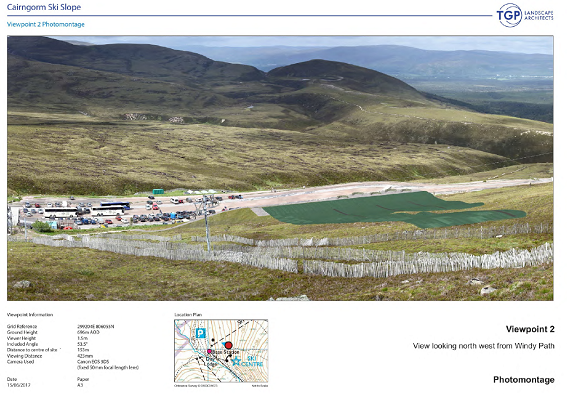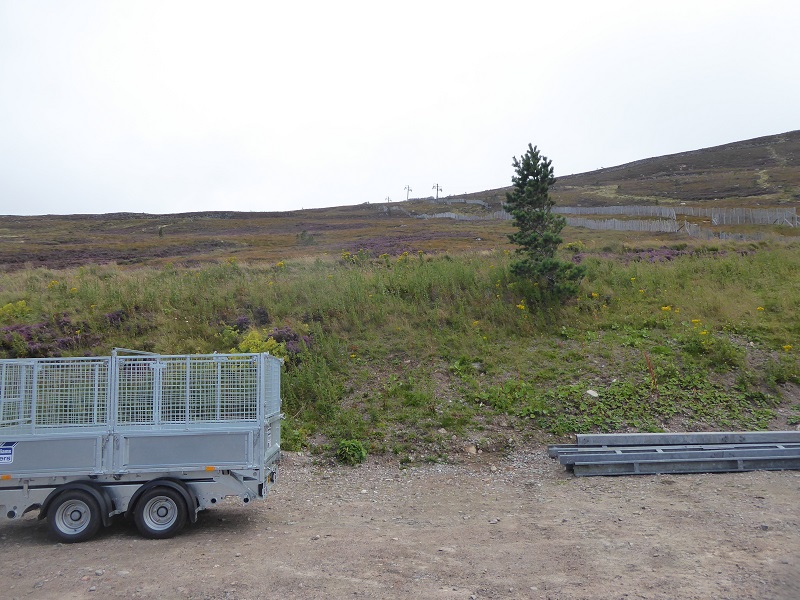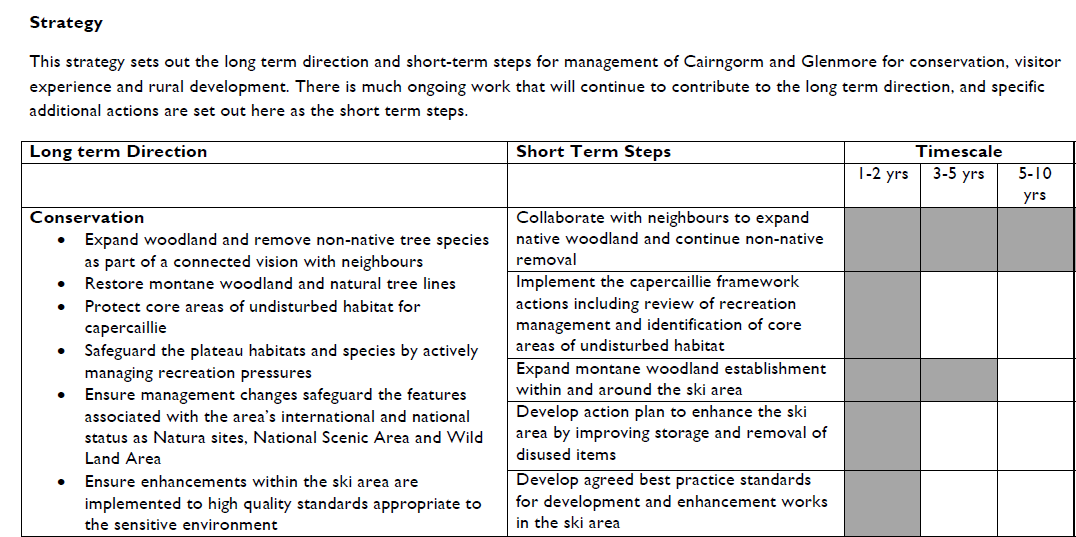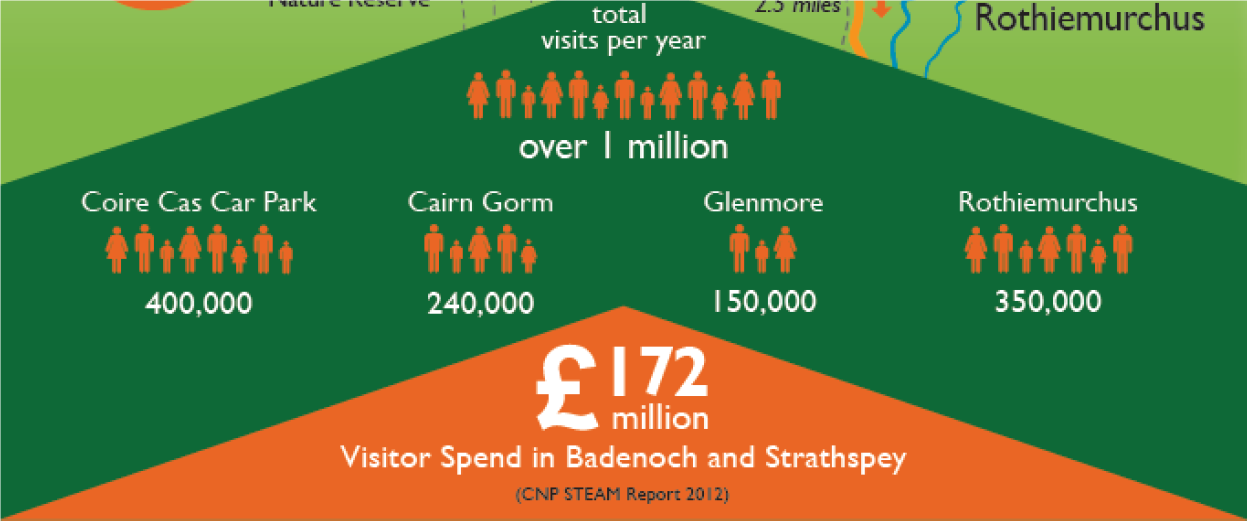 Yesterday the Cairngorms National Park Authority called in a planning application (see here) for a dry ski slope by the Coire Cas Car Park at Cairngorm which had been lodged at Highland Council by Cairngorm Mountain Ltd, whose registered address is now Wilmslow in Cheshire. The idea of a dry ski slope here was originally proposed a year ago when Highlands and Islands Enterprise announced its so called “agreed masterplan” for Cairngorm (see here) and a planning application was briefly submitted six months later after a drop-in public consultation session before being withdrawn. The delays had caused me to wonder if HIE had had a re-think – I should not have been so naive. HIE, once set on an idea, appear to be an organisation that is unable to change course, whether this is admitting they made a disastrous mistake in selling Cairngorm Mountain to the Natural Retreats group of companies or their continued attempts to make Cairngorm a year round visitor attraction. This post takes a critical look (see here for my original criticism) at the planning application for a dry ski slope.
Yesterday the Cairngorms National Park Authority called in a planning application (see here) for a dry ski slope by the Coire Cas Car Park at Cairngorm which had been lodged at Highland Council by Cairngorm Mountain Ltd, whose registered address is now Wilmslow in Cheshire. The idea of a dry ski slope here was originally proposed a year ago when Highlands and Islands Enterprise announced its so called “agreed masterplan” for Cairngorm (see here) and a planning application was briefly submitted six months later after a drop-in public consultation session before being withdrawn. The delays had caused me to wonder if HIE had had a re-think – I should not have been so naive. HIE, once set on an idea, appear to be an organisation that is unable to change course, whether this is admitting they made a disastrous mistake in selling Cairngorm Mountain to the Natural Retreats group of companies or their continued attempts to make Cairngorm a year round visitor attraction. This post takes a critical look (see here for my original criticism) at the planning application for a dry ski slope.
The proposal

As described the proposal is for:
- “A artificial ski slope measuring 60 m x 90m in a reverse ‘L’ shape with a surface area of c. 3000 (dark green colour); comprising
- a beginners area 60 metres wide by 30 metres long, served by three magic carpet lifts and
- an intermediate slope attached to the rear of the beginners area of up to 60 meters (90 meters in total) long and 20 meters wide served by a dedicated magic carpet lift.
- Cornice or man-made undulations within the ski slope;
- Barriers, fences and crash mats up to 2 m high and generally green in colour;
- New viewing area at lower slopes with low stone benches; and
- Drainage to the ski matting area and to the adjacent slopes to the west involving buried perforate”
The only rationale given for creating an artificial ski slope here is that HIE and Natural Retreats believe it will help Cairngorm as a business (see below). That I believe is totally mistaken:
- The slope above the Coire Cas carpark faces south west and is fully exposed to the prevailing wind. Not a good place for beginners or ski schools in the winter season when snow is in short supply low down. Even for people who believe a dry ski slope could add to what Cairngorm has to offer, this is the wrong location.
- Following criticisms of the proposal to use a material called snowflex, which is expensive, comes in just two fixed coloures and requires water sprays to work, Cairngorm Mountain has strangely avoided specifying what material will be used to construct the slope. However, if its snowflex, it appears unlikely the dry slope will be usable when frozen or covered with snow.
- The idea though that people will come to Cairngorm in summer in order to have a go at skiing on a tiny area of dry ski slope (the beginner’s areas is 40m long) – Natural Retreats laughably say this would create a world class facility – is totally wrong.
- Most people visiting Cairngorm in summer do so I believe because they want to see and feel what the mountains are like. For all its faults, arrive at the Coire Cas carpark, and you at least get a feeling that you are in the mountains, despite the ski clutter, and some of that is because of the area of moorland above the carpark (rather badly depicted in my photo above). HIE and Natural Retreats want to destroy that when they should be enhancing the natural mountain “experience”.
Indeed the planning application states that there are NO trees in the area covered by the planning application. That is factually wrong and, as well as the trees visible in the photo, the environmental assessment states “There are young Pinus sylvestris and small browsed Juniperus communis scattered throughout the wet heath area”. A more rational plan for the area, building on its natural heritage qualities, would be to encourage the development of montane scrub here along with paths to enable people to enjoy this. That might actually help make Cairngorm more worth visiting, instead more ugliness is proposed.
The landscape impact of the proposal
The planning application includes a 76 page landscape assessment which basically concludes that because the proposed development is next door to an existing development the impact will be not too bad. On this argument, once you have built one development, you could keep expanding on that ad infinitum. There is nothing in the assessment on the cumulative impact of developing a new area at Cairngorm and not just anywhere at Cairngorm but in the one place which is seen by every single visitor to Coire Cas.
The assessment does however make clear that the impact on the Coire Cas carpark area in landscape terms will be significant “the overall sensitivity of the character of the Site is Medium/ High, the magnitude of change would be Substantial and the effect Major” while going on to say that “the Proposed Development would affect a relatively small percentage of the LCT [landscape character type] which is well represented within the Study Area.” The implication appears to be if you have lots of open moorland, you can afford to lose some of it – that argument might be valid outwith a protected area, but this is in both the Cairngorms National Scenic Area and the Cairngorms National Park and not just that, but the most visited single area within it.
The report’s conclusion that the biggest impact will be from nearby (see top visualisation) is obviously correct, and the development will be less visible from a distance (working on the assumption the matting will be dark green):
The extent of the proposed ski area would become increasingly visible moving in an anti-clockwise
direction from, and visible as a change in colour as dark green against the patchwork greens and
browns of the surrounding moorland vegetation. The areas of reinstatement on the peripheries
of the ski matting would be viewed as disturbed peat and heather fragments, gradually returning
to heather moorland over time.
Again, while technically correct, this in my view it misses the point. Should the CNPA be allowing any development at Cairngorm which can be seen from a distance? The CNPA has rightly objected to windfarms outwith the National Park because of their long-range landscape impact and should, in my view apply, the same reasoning here. The challenge for the CNPA is to oversee the enhancement of the natural landscape at Cairngorm, not its further destruction.
HIE and Natural Retreat’s failures to consult and develop a proper plan for Cairngorm
 Under the Cairngorm and Glenmore Strategy agreed by the Cairngorms National Park Authority back in 2016 Natural Retreats and HIE were supposed to develop comprehensive plans for Cairngorm (see above) which might have provided a framework for addressing some of the issues raised by this planning application. That has not happened and there are regular references in CNPA Board Meeting Papers to “slow” – code for “no” – progress at Cairngorm. Instead, what has happened is HIE and Natural Retreats have gone away and come up with their own proposals without any meaningful consultation and then, despite now having had over a year to do so, failed to consult properly about these proposals before submitting a planning application.
Under the Cairngorm and Glenmore Strategy agreed by the Cairngorms National Park Authority back in 2016 Natural Retreats and HIE were supposed to develop comprehensive plans for Cairngorm (see above) which might have provided a framework for addressing some of the issues raised by this planning application. That has not happened and there are regular references in CNPA Board Meeting Papers to “slow” – code for “no” – progress at Cairngorm. Instead, what has happened is HIE and Natural Retreats have gone away and come up with their own proposals without any meaningful consultation and then, despite now having had over a year to do so, failed to consult properly about these proposals before submitting a planning application.
The best illustration of how corrupt this process is HIE’s review of ski infrastructure at Cairngorm which is currently being undertaken by external consultants (see here). In what sense can this review, which cost another £80k or so, be meaningful, when HIE has already decided the best way forward is to commit £1.5m of public monies to pay for an artificial slope at Coire Cas? HIE and Natural Retreats are crashing on regardless of whether there might be alternative (and better) proposals for how this money might be invested.
The failure to develop a proper plan however also means a whole range of issues which need to be addressed at Cairngorm continue either to be ignored or mismanaged:

There has been no sign of collaboration with neighbours on expanding native woodland and while there has been some planting in Coire Cas, that has only been because the CNPA required this in compensation for the damage done by HIE and Natural Retreats when installing the Shieling Rope tow. There is still no sign of the best practice standards the CNPA asked HIE and Natural Retreats to adopt for management of the ski area (eg on off road vehicle use) and while HIE has paid for a clear-up of some of the ski area, the main motivation for this appears to have been to remove all ski infrastructure from Coire na Ciste – again pre-empting the review of ski infrastructure. A catalogue of failure!
A proper plan for Coire Cas would have been looking at how to reduce the landscape impact of the existing car park (fitting in with the CNPA aspiration to improve public transport up the mountain) and how the area around it could be enhanced.
The business justification for a dry ski slope in Coire Cas
Accompanying the planning application is a business case which shows that Cairngorm Mountain makes most of its money in winter – out of skiers. Instead of concluding from this that investment is needed in winter facilities – as is being called for by skiing interests and the local community – the business case reaches the opposite conclusion:
Business Impact/Model
• This current operation creates an unsustainable model of seasonal revenue generation. Comment: why? Other ski areas manage. This is exacerbated by a lower spend per head combined with lower visitor numbers in summer compared to winter. Comment: this affects ski areas across the world – others cope
• The uneven distribution of revenue becomes even more unsustainable when the snowfall upon which the winter revenue is dependent fails to materialise. This was the case recently as the Winter of 2016/7 was the worst winter for snow cover since 2002/3 and is having an immense effect on the operation of the business and wider community. Comment: the dry ski slope will never make up for lack of snow cover – investing in snow making in Coire na Ciste might, just
• The over dependency on unreliable winter revenue does not allow the business to forward plan for the investment in and improvement of facilities on the mountain – namely ski infrastructure. The negative impact on revenue caused by unreliable winters also has a direct impact on the summer land management initiatives and maintenance regimes required on the mountain. Comment: this is a completely circular argument, claiming lack of summer revenue prevents investment in winter and lack of winter revenue prevents investment in summer.
• A solution needs to be sought to stabilise the unsustainable, seasonal revenue generation and allow for long term planning for the growth of the operation. Comment: why, when all the other ski centres manage with an uneven distribution of revenue across the year, does Cairngorm need to be different? Isn’t the importance of Cairngorm to the local economy primarily about attracting paying visitors in winter and extending the tourism season?
Cairngorm Mountain appear to be in cloud cuckoo land when they state they wish to:
“Capture a greater share of the current summer visitors already in the National Park, Aviemore and Glenmore corridor by attracting them to the mountain with new and improved facilities”
The facts, as reported in the Glenmore and Cairngorm Strategy consultation, are:

So, more visitors go to Cairngorm already than to either Glenmore (where there are few places to stop) or to Rothiemurchus but the issue from a Cairngorm Mountain business perspective is they don’t spend much on the mountain. I suspect that’s primarily because they visit to experience nature – a suspicion supported by the note in the business case that the guided walks from the top of the funicular to the summit of Cairngorm are popular. The question HIE/Natural Retreats have completely failed to answer is why would such people want to use a dry ski slope?
What is entirely lacking from the business case is any survey/consultation of what people actually want when they go to Cairngorm. I believe most people visiting the Cairngorms do so for nature, NOT development.
Indeed what other “world class” ski resorts operate dry ski slopes in summer? Ski resorts throughout the Alps accept that business in summer is going to be significantly less than in winter but those that do diversify try to make use of natural assets and their ski infrastructure. The growth of mountain biking is the best example. The problem at Cairngorm is that the lift system is not fit for mountain biking, the funicular being unusable and leading to very fragile areas at the top of the mountain. The business case states that because of this mountain biking is not being pursued for the time being but fails to mention that a chairlift lower down might meet environmental concerns and provide a service that people might actually want. Wouldn’t this be a better investment? Rather than wait for a review of the ski infrastructure, however, and consider alternative options HIE wants to fork out public money for a dry ski slope.
The financial issues surrounding the proposal
HIE agreed last year to lend “Natural Retreats” £4 million to redevelop the Ptarmigan and install a dry ski slope and of this about £1.5 million is earmarked for the dry ski slope. While like the funicular, if the dry ski slope idea ever went ahead, it would have a very high chance of becoming a white elephant unlike the funicular, the entire development would be publicly funded. Even more reason to get the investment right one might have thought.
However, HIE appears to be proposing to lend public money to Cairngorm Mountain Ltd, a company which is effectively bankrupt, with very few tangible assets and what assets there are are outweighed by its liabilities. The companies that own and operate it are in a similar position. Financing the development through a loan in these circumstances appears the height of financial folly. I have been in correspondence with Charlotte Wright, the Chief Executive of HIE about this, and so far have had only bland assurances HIE has robust risk assessment procedures in place but no meaningful information about how HIE intends to secure its loan given the financial position of the companies concerned. Its about time Audit Scotland took an interest in the entire shambles.
The capability of HIE and Cairngorm Mountain to carry out the proposed works
The track record of HIE and Natural Retreats in ensuring that work at Cairngorm is carried out to the appropriate standard is extremely poor – as far as I am aware they have still not produced a standards document as requested by CNPA over a year ago. For example the planning conditions for the Shieling rope tow were widely ignored (see here) while HIE failed to supervise the removal of the Ciste ski towers leaving dangerous sawn off spike sticking up out of the snow. I hope CNPA will chuck this application out but if they don’t, they need to be mindful of the significant resources which they will require to supervise the proposed development here (and at the Ptarmigan) properly.
What needs to happen
While rational argument helps, at the end of the day its the level of public opposition which will help determine this planning application and I would urge anyone who is concerned about this development to lodge an objection on the CNPA planning portal under the comments section (see here).
In the medium term, what we need is a proper plan for Cairngorm developed in consultation with stakeholders, including the local community, skiers, outdoor recreationists and conservation interests. That is clearly not going to happen while HIE continue to own and “Natural Retreats” continue to operate Cairngorm. That is why all those who care about Cairngorm need to support the efforts of the Aviemore and Glenmore Community Trust to take over Cairngorm. Only when that happens, I believe, will the management of Cairngorm start to change for the better.
